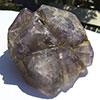Mohs Scale of Mineral Hardness
The Mohs scale of mineral hardness characterizes the scratch resistance of various minerals through the ability of a harder material to scratch a softer material.
It was created in 1812 by the German mineralogist Friedrich Mohs and is the most popular of several definitions of hardness in materials science.
Mohs based the scale on ten minerals that are all readily available. As the hardest known naturally occurring substance when the scale was designed, diamonds are at top of the scale. (However, new minerals found from asteroids or formed during volcanic eruptions have proven to be harder) The hardness of a material is measured against the scale by finding the hardest material that the given material can scratch, and/or the softest material that can scratch the given material. For example, if some material is scratched by apatite but not by fluorite, its hardness on the Mohs scale would fall between 4 and 5.
The Mohs scale is a purely ordinal scale. For example, corundum (9) is twice as hard as topaz (8), but diamond (10) is almost four times as hard as corundum.
| Hardness | Mineral | |
|---|---|---|
| 1 | Talc (Mg3Si4O10(OH)2) |  |
| 2 | Gypsum (CaSO4 2H2O) |  |
| 3 | Calcite (CaCO3) |  |
| 4 | Fluorite (CaF2) |  |
| 5 | Apatite (Ca5(PO4)3(OH-,Cl-,F-) |  |
| 6 | Feldspar (KAlSi3O8) |  |
| 7 | Quartz (SiO2) |  |
| 8 | Topaz (Al2SiO4(OH-,F-)2) |  |
| 9 | Corundum (Al2O3) |  |
| 10 | Diamond (C) |  |
On the Mohs scale, a pencil "lead" (graphite) has a hardness of 1; a fingernail, 2.5; a copper penny, about 3.5; a knife blade, 5.5; window glass, 5.5; and a steel file, 6.5. Using these ordinary materials of known hardness can be a simple way to approximate the position of a mineral on the scale.
